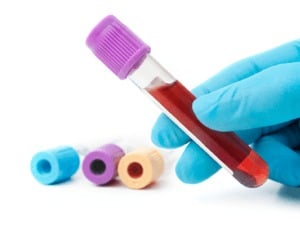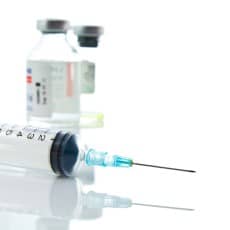Implementation of disinfecting port protectors to reduce CLABSI

Disinfecting port protectors are a supplement to the central line-associated bloodstream infection prevention bundle as an optional recommendation from the Centers for Disease Control and Prevention” Beeler et al (2019). Abstract: Disinfecting port protectors are a supplement to the central line-associated bloodstream infection prevention bundle as an optional recommendation from the Centers for Disease Control […]
Review of hemodialysis catheter associated right atrial thrombus

To study the magnitude of the complication of catheter associated right atrial thrombus (CRAT) in patients with tunnelled central venous hemodialysis catheters (THC) for maintenance hemodialysis (MHD)” Bichu et al (2018). Abstract: OBJECTIVE: To study the magnitude of the complication of catheter associated right atrial thrombus (CRAT) in patients with tunnelled central venous hemodialysis catheters […]
Ultrasound-guided peripheral IV catheter placement using a guidewire

The purpose of this pilot study was to investigate whether use of a guidewire improves successful placement of ultrasound-guided peripheral IVs (PIV) in difficult intravenous access patients in the emergency department (ED)” Cochrane et al (2019). Abstract: Objective: The purpose of this pilot study was to investigate whether use of a guidewire improves successful placement […]
Outcomes of implementing a central venous catheter bundle

This study done at All India Institute of Medical Sciences showed improved outcome in terms of catheter infection and mechanical complications” Krishnan et al (2018). Abstract: INTRODUCTION: Central venous catheter (CVC) associated infection are many times higher in India compared to western countries. A group of interventions called as CVC bundle, if implemented effectively prevents […]
Skin colonization at peripheral intravenous catheter insertion sites

In this study, the impact of PIVC skin site colonization on tip colonization and the development of CRBSI was investigated” Choudhury et al (2019). Abstract: BACKGROUND: Peripheral intravenous catheters (PIVCs) break the skin barrier, and preinsertion antiseptic disinfection and sterile dressings are used to reduce risk of catheter-related bloodstream infection (CRBSI). In this study, the […]
Implantable port placement in patients at risk of lymphedema

There was no difference in port complications or lymphedema rates between patients who had ports placed on the ipsilateral side compared with the contralateral side for breast cancer treatment” Isom et al (2019). Abstract: BACKGROUND: Central venous ports placed for breast cancer treatment have traditionally been placed contralateral to the disease. This is done out […]
Report of PICC embolization following surgical procedure

In this report, we describe a rare scenario of catheter breakage, entrapment, and embolization in a patient caused by inadvertent surgical clip and suture placement” More et al (2019). Abstract: Peripherally inserted central catheters (PICCs) are a feasible alternative to conventional central venous access. PICCs are often used perioperatively for central venous pressure monitoring and […]
Evaluation of implanted venous ports in children with complex needs

To analyze the use of implanted port-a-caths in children with medical complexity who have neurologic impairment and difficult venous access” Pezeshkpour et al (2019). Abstract: BACKGROUND: Children with medical complexity and associated neurologic impairment frequently face difficulties with venous access. Intermittently they require urgent intravenous administration of fluids and medication. OBJECTIVE: To analyze the use […]
Augmented ultrasound technique for central venous cannulation

Two-dimensional ultrasound (2DUS) guidance for central venous cannulation is a best-practice for patient safety identified by the Agency for Healthcare Research and Quality and the American College of Emergency Physician” Broder et al (2019). Abstract: Two-dimensional ultrasound (2DUS) guidance for central venous cannulation is a best-practice for patient safety identified by the Agency for Healthcare […]
Analysis of insurance claims from central venous access injuries

The aim was to analyse injuries reported to the Swedish National Patient Insurance Company (Löf) within 7 days after insertion or removal of a CVAD” Lindgren et al (2019). Abstract: INTRODUCTION: Insertion and use of central venous access devices (CVADs) can be associated with serious adverse events. The incidence is generally low but considering the […]
Loss of guidewire and its sequelae after central venous catheterization

Here, we report a peculiar case of a missed guidewire puncturing the aortic arch and cerebrum” Zhao et al (2019). Abstract: RATIONALE: Central venous catheterization is a common tool used to monitor central venous pressure and administer fluid medications in patients undergoing surgery. The loss of a broken guide wire into the circulation is a […]
Implementation of second-tier prevention practices and CLABSI rates

Implementation of second-tier preventive practices was protective against CLABSI. Use of more practices was correlated with lower rates” Ben-David et al (2019). Abstract: BACKGROUND: Prevention of central-line-associated bloodstream infection (CLABSI) represents a complex challenge for the teams involved in device insertion and maintenance. First-tier practices for CLABSI prevention are well established. OBJECTIVE: We describe second-tier […]
Etiology and management of upper-extremity catheter-related thrombosis

Catheter-related thrombosis (CRT) is a common complication of central venous access devices in oncology patients. Risk factors for CRT include patient-, device-, and treatment-related risk factors” Rajasekhar et al (2019). Abstract: Central venous access devices are a critical instrument in the treatment and supportive care delivery for oncology patients. Catheter-related thrombosis (CRT) is a common […]
Removing unnecessary centrally inserted central catheters

This probably shows that the combination of the five evidence-based procedures recommended by the Centers for Disease Control and Prevention together with that of ultrasound-guided peripheral venous cannulation method can increase the compliance with the Category IA recommendation for removal or avoidance of unnecessary placement of centrally inserted central catheters” Iordanou et al (2019). Abstract: […]
Impact of multiple concurrent central lines on CLABSI rates

The current methodology for calculating central-line-associated bloodstream infection (CLABSI) rates, used for pay-for-performance measures, does not account for multiple concurrent central lines” Couk et al (2019). Abstract: BACKGROUND: The current methodology for calculating central-line-associated bloodstream infection (CLABSI) rates, used for pay-for-performance measures, does not account for multiple concurrent central lines. OBJECTIVE: To compare CLABSI rates […]
Air embolism through open hub of external jugular vein intravenous cannula

We are reporting a case of sudden pulmonary air embolism in a patient through the open hub of an intravenous cannula” Mohanty et al (2019). Abstract: INTRODUCTION: Venous air embolism is a catastrophic complication that can result in sudden cardiac arrest and death. Massive air embolism has been reported with central venous catheter through the […]
Prehospital interventions performed on wartime pediatric trauma casualties

We describe injury characteristics and prehospital interventions performed on wartime pediatric trauma casualties in Afghanistan and Iraq, stratified by medical evacuation platform” Naylor et al (2019). Abstract: Background: Traumatic injuries were the most common reason for pediatric admission to military hospitals during the recent wars in the Middle East. We describe injury characteristics and prehospital […]
The case for using a disinfecting cap for needlefree connectors

Catheter-related bloodstream infections (CRBSIs) are a signification cause of infection. When CRBSI rates are high, the cost to the patient and the organisation can be significant” Barton (2019). Abstract Catheter-related bloodstream infections (CRBSIs) are a signification cause of infection. When CRBSI rates are high, the cost to the patient and the organisation can be significant. […]
Health professionals’ lack of knowledge of central venous access devices

It suggests that patients accept having a CVAD as it should reduce episodes of repeated cannulations. However, a recent doctoral study found the reality did not live up to this hope” Kelly et al (2019). Abstract Background: the literature on the patient experience of living with a central venous access device (CVAD) is growing, but […]
Clinical experiences of using ports and non-coring needles

The following case studies describe the use of the Smith Medical implanted ports and Gripper huber needles” Meade et al (2019). Abstract: The following case studies describe the use of the Smith Medical implanted ports and Gripper huber needles. Smiths Medical produces a range of implanted ports that include the Port-A-Cath and P.A.S. Port Power […]
Article examines components and selection of implantable ports

This article describes the different types and components of ports and how to select them. It explains how to insert ports, and provides guidance on accessing and de-accessing them” Hodson (2019). Abstract: Uses of central venous access devices (CVADs) include the administration of vital fluids and medications. Implanted ports are a type of CVAD that […]
Best practice for using ports and non-coring needles

This article explores the additional equipment required to be able to access ports” York (2019). Abstract: Ports are predominately inserted into oncology patients, but their use is becoming increasingly popular for other indications, such as cystic fibrosis. These devices not only provide patients and health professionals with reliable vascular access, but also preserve vessel health […]
Unconventional diagnostic tests for Lyme borreliosis

Lyme borreliosis (LB) diagnosis currently relies mainly on serological tests and sometimes polymerase chain reaction or culture. However, other biological assays are being developed to try to improve Borrelia-infection diagnosis and/or monitoring” Raffetin et al (2019). Abstract: Background: Lyme borreliosis (LB) diagnosis currently relies mainly on serological tests and sometimes polymerase chain reaction or culture. […]
Review of antibiotic overuse in the intensive care unit

To review the literature exploring how we diagnose infection in patients in the ICU and address the safety and utility of a “watchful waiting” approach to antibiotic initiation with selected patients in the ICU” Denny et al (2019). Abstract: Background: Most Intensive Care Unit (ICU) patients receive broad-spectrum antibiotics. While lifesaving in some, in others […]
PICC placement led by technicians is feasible and safe

PICC placement led by technicians is feasible and safe without statistical difference in terms of complications compared to PICC placement made by radiologists” Chasseigne et al (2019). Abstract: PURPOSE: The purpose of this study was to evaluate a cooperation program in order to compare incidence of complications after peripherally inserted central catheter (PICC) placement between […]
Evaluation of the activity of heparin injected into an implantable port

We can conclude that lock of heparinized solution used in our service in fully implantable central venous catheters for chemotherapy, was maintained with active heparin even after a long period of time (up to 30 days), demonstrating that the half-life of the substance within the catheter is greater than its plasma half-life” Pacheco Annicchino Baptistella […]
Impact of home parenteral nutrition and the older adult

In this large cohort study, increasing age was found to be protective against CRBSI” Bond et al (2019). Abstract: INTRODUCTION: The population in developed countries is getting older and with advancing age comes increasing co-morbidity and demand on health care services. The use of home parenteral nutrition (HPN) is also increasing in the UK and […]
Prevalence of complications associated with hemodyalisis CVAD

Ultrasonographic guidance is associated with a reduction in the prevalence of central venous line complications” Müller-Ortiz et al (2019). Abstract: BACKGROUND: Placing central venous lines under ultrasonographic guidance reduces the complications of the procedure. AIM: To compare prevalences of complications of central venous line placements with or without ultrasonographic guidance. MATERIAL AND METHODS: Descriptive study […]
The inside-out technique for tunneled dialysis catheter placement

The “inside-out” technique eliminates the need for subclavian or femoral catheter placement by placing a supraclavicular catheter via a percutaneous femoral vein access” Freeman et al (2019). Abstract: The “inside-out” technique eliminates the need for subclavian or femoral catheter placement by placing a supraclavicular catheter via a percutaneous femoral vein access. Few reports of its […]
Integrated OPAT treatment of patients with opioid use disorder

outpatient clinic that combines office-based opioid treatment with buprenorphine pharmacotherapy and counseling services with OPAT” Fanucchi et al (2019). Abstract: Persons with opioid use disorder (OUD) hospitalized with severe, injection-related infections (SIRI) are frequently hospitalized for the duration of IV antibiotic treatment due to concerns regarding their eligibility for outpatient parenteral antimicrobial therapy (OPAT), which […]

